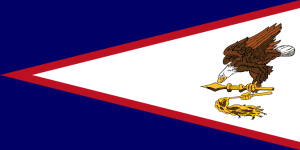
| Colors | HEX Code | RGB | CMYK |
|---|---|---|---|
| Blue | #000066 | 0, 0, 102 | 100, 100, 0, 60 |
| White | #FFFFFF | 255, 255, 255 | 0, 0, 0, 0 |
| Red | #BD1021 | 189, 16, 33 | 0, 92, 83, 26 |
| Brown | #553418 | 85, 52, 24 | 0, 39, 72, 67 |
| Yellow | #FFC221 | 255, 194, 33 | 0, 24, 87, 0 |
The American Samoa flag has a blue background with a white triangle pointing toward the mast. The white triangle is bordered by a red line. In the middle of the white triangle, a bald eagle holds traditional Samoan symbols. It clutches a war club in one claw while holding an orator’s fly trap or a fly whisk in the other.
Meaning of the flag
The red, blue, and white represent the United States of America. The war club represents the power of the state, while the fly whisk is the symbol of the wisdom of the Samoan chiefs. The bald eagle is also a symbol of the United States. The eagle clutching the Samoan emblems stands for the protection the United States provides for American Samoa, and the alliance between the two nations.
History of the flag
Samoa did not have a flag of its own. In the 18th century, the Europeans visited Samoa and then The United States, Germany, and the United Kingdom wanted to claim the country as their own. In 1899, the three countries agreed to split Samoa into three parts, with each nation taking a part. The American part which was the far east of Samoa first adopted the American flag in 1900, and it remained the official flag there until the year 1960. As Samoans became more involved in governing their country, The U.S. Army of Heraldry together with Samoan leaders created the current flag which was adopted on April 27, 1960. 60 years after hoisting the American flag, American Samoa raised its own flag officially as its constitution went into effect. The flag shows the close relationship of respect between the United States and American Samoa.